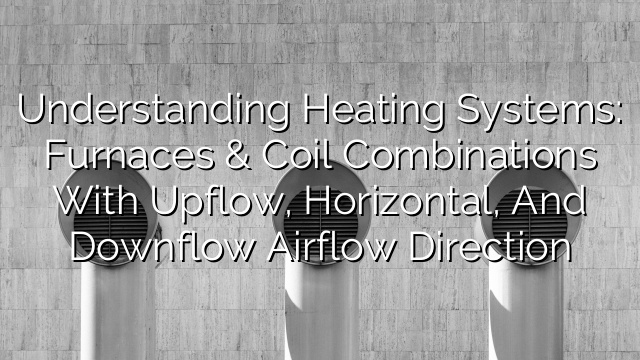Heating, Furnaces & Coil Combinations, Airflow Direction: Upflow, Horizontal, Downflow
When it comes to heating systems, there are several factors to consider. One important factor is the airflow direction of the furnace and coil combinations. The three most common airflow directions are upflow, horizontal, and downflow. In this article, we will discuss each of these airflow directions, along with their advantages and disadvantages.
Understanding Heating Systems: Furnaces & Coil Combinations with Upflow, Horizontal, and Downflow Airflow Direction
1. Upflow Airflow Direction
In an upflow heating system, the air flows upward from the bottom of the furnace. This type of airflow direction is commonly used in basement or crawl space installations. The furnace is typically installed in a vertical position, with the return air duct located at the bottom and the supply air duct located at the top. The heated air is then distributed through the supply air ducts, which can be located in the floor or the walls.
Advantages:
- Upflow heating systems are generally more energy-efficient than other types of systems because the heated air naturally rises.
- These systems are ideal for installations in basements or crawl spaces, where space is limited.
- Upflow furnaces have a smaller footprint, making them easier to install in tight spaces.
Disadvantages:
- If the ductwork isn’t properly sealed, there may be air leaks that can reduce the system’s efficiency.
- Since the return air is located at the bottom of the furnace, there is a higher chance of dirt and debris entering the system.
- Upflow systems may require additional equipment, such as a condensate pump, to remove the condensate that is produced during the heating process.
2. Horizontal Airflow Direction
A horizontal heating system is designed to provide airflow in a horizontal direction. These systems are commonly used in attics or storage areas where vertical space is limited. The furnace is typically installed horizontally, with the return air duct located on one side and the supply air duct located on the other side. The heated air is then distributed through the supply air ducts, which can be located in the ceiling or the walls.
Advantages:
- Horizontal heating systems are the preferred choice when vertical space is limited.
- These systems allow for easy installation and serviceability since the furnace is easily accessible.
- Horizontal furnaces provide even airflow throughout the space, reducing hot or cold spots.
Disadvantages:
- Since the furnace is located in the attic or storage area, there may be a higher chance of dirt and debris entering the system.
- Horizontal systems may require additional equipment, such as a condensate pump, to remove the condensate that is produced during the heating process.
- The size of the supply air ducts may need to be larger to accommodate the longer distance of airflow.
3. Downflow Airflow Direction
A downflow heating system is designed to provide airflow in a downward direction. These systems are commonly used in applications where the furnace is located in an upstairs closet or utility area. The furnace is typically installed in a vertical position, with the return air located at the top and the supply air located at the bottom. The heated air is then distributed through the supply air ducts, which can be located in the floor or the walls.
Advantages:
- Downflow heating systems are ideal for installations in two-story homes, where the furnace is located on the upper level.
- These systems provide even heating throughout the space, eliminating hot or cold spots.
- Downflow furnaces typically have a built-in condensate drain, eliminating the need for additional equipment.
Disadvantages:
- Since the return air is located at the top of the furnace, there is a higher chance of dirt and debris entering the system.
- Downflow systems may require additional equipment, such as a drain pan, to prevent water damage in case of a condensate drain blockage.
- The location of the furnace may require additional ductwork modifications, leading to increased installation costs.
Frequently Asked Questions
- Which airflow direction is the most energy-efficient?
Upflow heating systems are generally more energy-efficient than horizontal or downflow systems. This is because the heated air naturally rises, eliminating the need for additional energy consumption.
- How can I determine the airflow direction of my heating system?
You can determine the airflow direction of your heating system by checking the direction of the supply air registers. If the air is blowing upward, you have an upflow system. If the air is blowing horizontally, you have a horizontal system. If the air is blowing downward, you have a downflow system.
- Can I convert my heating system to a different airflow direction?
In most cases, it is not recommended to convert the airflow direction of your heating system. The system is designed to work with a specific airflow direction, and any modifications may result in reduced efficiency or system damage.
- Do I need to hire a professional to install or service my heating system?
It is highly recommended to hire a professional HVAC technician to install or service your heating system. They have the knowledge and experience to ensure proper installation and optimal performance of your system.
- How often should I have my heating system serviced?
It is recommended to have your heating system serviced annually by a qualified HVAC technician. Regular maintenance can help prevent system breakdowns and ensure efficient and safe operation.




